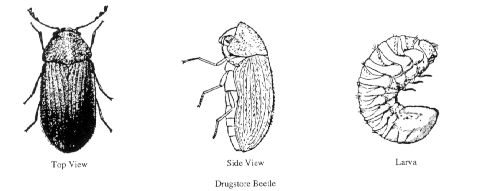With the bug you found still in the trash and forgotten about, it’s time for a late night snack. You open the pantry and peruse your choices. Hmmm, crackers, maybe some popcorn or some—-huh? what? There’s another bug just like the one earlier. I thought I killed that–huh?what? theres one, ooh another–oh my goodness theres a bunch what the? Oh how could this happen? Look at em all. That d@% bug man, I’m calling them tomorrow.
the pantry and peruse your choices. Hmmm, crackers, maybe some popcorn or some—-huh? what? There’s another bug just like the one earlier. I thought I killed that–huh?what? theres one, ooh another–oh my goodness theres a bunch what the? Oh how could this happen? Look at em all. That d@% bug man, I’m calling them tomorrow.
Has this happened to you? Chances are it has and it’s not surprising. When it comes to beetles their are over 250,000 species and they can thrive in almost any conceivable habitat. From swimming in pond scum to living under rocks or in and around animal manure. Moths too are quite numerous and eat our clothing, carpeting, or food stuffs. In fact, in most third world countries ’stored product pests’ are the main culprit for food shortages. With poor grain management techniques sometimes as much as 50% of stored grains become unusable due to a grain pest. Even in America we throw away perhaps 10% of all food products due to these insects alone.
It would be impossible to list and describe all of the species so we’ll just concentrate on the stored product pest you’re most likely to encounter and what you can do to eliminate the pest from your home.
Lets begin with moths. Moths are usually the end result of a life cycle so seeing them indicates 3 other stages that are’nt far away. Eggs, larva and pupae. So to rid one stage, (the adult moth) is only 1/3 of the battle and won’t result in elimination. The most common moth pests are;
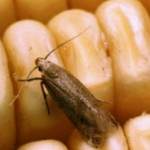 Angoumois Moth which is considered a primary grain pest because they only attack whole grain. The larvae develop in undamaged grain, corn, barley, rye, oats, rice and other seeds. Excellent fliers they are often confused with the clothes moth however these pests are seen during daylight hours and clothes moths do not frequent out when the lights are on. Females lay about 40 eggs during her life on or near grain. The eggs hatch in 4 to 8 days and the larva bore into the whole grain where they feed. The larva go through 3 molts until fully developed (in that stage) which takes 2 to 3 weeks. Then they pupate in the kernel and emerge as adults in about 10 to 24 days. Usually they have 4 or 5 generations per year but as many as 12 in higher temperatures.
Angoumois Moth which is considered a primary grain pest because they only attack whole grain. The larvae develop in undamaged grain, corn, barley, rye, oats, rice and other seeds. Excellent fliers they are often confused with the clothes moth however these pests are seen during daylight hours and clothes moths do not frequent out when the lights are on. Females lay about 40 eggs during her life on or near grain. The eggs hatch in 4 to 8 days and the larva bore into the whole grain where they feed. The larva go through 3 molts until fully developed (in that stage) which takes 2 to 3 weeks. Then they pupate in the kernel and emerge as adults in about 10 to 24 days. Usually they have 4 or 5 generations per year but as many as 12 in higher temperatures.
Indian Meal Moth. Also one of the most common stored product pests the Indian meal moth larva 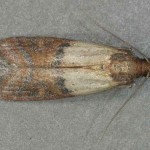 feed on loose flour or meal but can be found on whole grains as well. Dried fruit, nuts, chocolate, beans, crackers, biscuits, dog food, and red peppers make for quite the diet.The larva produce a webbing over the surface of the food they’re eating that gets filled with frass and feces. These insects usually over winter as larva. The females will lay as many as 400 eggs in 18 days.The larva move to cracks and crevices in the food material. Mature larva ready to pupate will often move away from the food to cracks and crevices in the area for protection. There are usually 4 to 6 generations per year, more if food supply and temperatures are favorable.
feed on loose flour or meal but can be found on whole grains as well. Dried fruit, nuts, chocolate, beans, crackers, biscuits, dog food, and red peppers make for quite the diet.The larva produce a webbing over the surface of the food they’re eating that gets filled with frass and feces. These insects usually over winter as larva. The females will lay as many as 400 eggs in 18 days.The larva move to cracks and crevices in the food material. Mature larva ready to pupate will often move away from the food to cracks and crevices in the area for protection. There are usually 4 to 6 generations per year, more if food supply and temperatures are favorable.
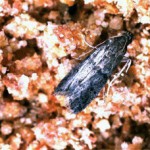 Mediterranean Flour Moth. Considered a major pest of flour mills they infest a wide variety of food stuffs. (much the same as the Indian meal moth) The larva also produce webbing in which they feed, at times this can get so heavy that it will clog the machinery at the mill and it needs to be shut down for cleaning. The female lays her eggs in the flour or other food and the eggs hatch in about 5 days. The larva feed in the webbing and become mature in about 40 days. Spinning a cocoon the larva then pupate for 8 to 12 days then emerging as adults. The entire cycle is about 10 weeks and they can have as many as 5 generations per year.
Mediterranean Flour Moth. Considered a major pest of flour mills they infest a wide variety of food stuffs. (much the same as the Indian meal moth) The larva also produce webbing in which they feed, at times this can get so heavy that it will clog the machinery at the mill and it needs to be shut down for cleaning. The female lays her eggs in the flour or other food and the eggs hatch in about 5 days. The larva feed in the webbing and become mature in about 40 days. Spinning a cocoon the larva then pupate for 8 to 12 days then emerging as adults. The entire cycle is about 10 weeks and they can have as many as 5 generations per year.
Control of moths;
#1 is to try and identify the pest. It may help you narrow your search as to possible food items infested.
# 2 you need to find the infested food products and discard them. You may see the larvae or tiny BB size holes chewed in the bags or boxes. Adult moths will often be trapped and visible as well.
#3 Remove everything from the cabinets where the food was stored, vacuum the cracks and seams of the shelves to remove any pupae or larvae and loose grain products in which they can infest later. If you have wire shelving it’s most likely the larvae will have dropped to the floor area and are in the cracks along the baseboard. At this time I suggest bleaching the area, wipe clean and let dry. You 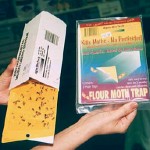 could then apply a residual insecticide to the cracks if you wish but it’s not likely to add to current control effort however the residual may kill wandering larvae later if you missed some or if another package was also infested. Lure traps with pheremones should then be placed in the immediate area to catch any missed adults. These can be purchased on line or at most pest do it yourself centers. (pricey though). The sticky trap used to catch the moths will get filled up quickly with the use of pheromones so I’d suggest using a vacuum attachment to suck up the moths hanging out near the area.
could then apply a residual insecticide to the cracks if you wish but it’s not likely to add to current control effort however the residual may kill wandering larvae later if you missed some or if another package was also infested. Lure traps with pheremones should then be placed in the immediate area to catch any missed adults. These can be purchased on line or at most pest do it yourself centers. (pricey though). The sticky trap used to catch the moths will get filled up quickly with the use of pheromones so I’d suggest using a vacuum attachment to suck up the moths hanging out near the area.
#4 Although we’re dealing with pantry issues don’t limit your efforts to just that area. Larvae and adults can and do show up sometimes far away from where the original infestation is. If you have birds, check the bag of seed, look at the dog biscuit box or the decorative corn or dried seed arrangement you may have on the wall or table. (this is a common place we find them around Thanksgiving time). Moths can be quite botersome and make life downright miserable if left unchecked. If the amount of food you have to discard is too great you can always throw the foodstuffs in the freezer. This will halt any further development and you can cook the food later. (Eck, I can’t believe I just said that, but it is an option I guess)
Since mouse and rat baits are also made of grain products, check to see if that isn’t the source. You may have placed some behind the fridge years ago and forgotten it. Look for any foodstuffs that could support this infestation, an old cereal box or spilled pasta, anything anywhere. It usually does not take much so no small amount should be overlooked. Generally they’ll give their position away if you follow the trail back to the source.
The Drugstore Beetle female will lay her eggs on a food source or many food
sources if available. She can lay as many as 75 eggs in her lifetime. Temperature and relative humidity play a huge roll on numbers and development for this beetle. Anything around 85 degrees with 60 % or higher relative humidity is optimum. From egg to adult can take 5 months under ideal conditions but more commonly it takes 7 months. In most cases there are 4 generations per year. This beetle can easily chew through food packaging and is commonly found in books as well.
Cigarette Beetle gets is name from it’s serious tobacco infestations. The female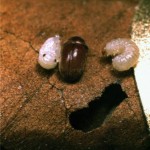 lays 30 to 40 eggs over a period of several weeks, usually in tobacco or some other suitable food source. The larva hatch in about 6 to 10 days. The larva avoid light and take 5 to 10 weeks to mature enough to enter the pupal stage. The entire cycle can take up to 90 days with as many as 6 or more over lapping generations per year. The shorter life cycle allows quicker build up of this beetle and the adults are proficient fliers which allows the infestation to spread to uninfected areas. They prefer low lit areas but like the drugstore beetle they can be found in a variety of food products. The key to controlling these beetles is finding the breeding source which can be a very small amount of food in a crack or crevice that has accumulated. It does not take much spillage at all to perpetuate a severe beetle infestation. Once the areas or infested products are found the same basic steps listed in the moth section above are needed to eradicate these pests. There are lure traps but don’t get the wrong one because of a misidentification, moth lures won’t attract beetles and vice versa.
lays 30 to 40 eggs over a period of several weeks, usually in tobacco or some other suitable food source. The larva hatch in about 6 to 10 days. The larva avoid light and take 5 to 10 weeks to mature enough to enter the pupal stage. The entire cycle can take up to 90 days with as many as 6 or more over lapping generations per year. The shorter life cycle allows quicker build up of this beetle and the adults are proficient fliers which allows the infestation to spread to uninfected areas. They prefer low lit areas but like the drugstore beetle they can be found in a variety of food products. The key to controlling these beetles is finding the breeding source which can be a very small amount of food in a crack or crevice that has accumulated. It does not take much spillage at all to perpetuate a severe beetle infestation. Once the areas or infested products are found the same basic steps listed in the moth section above are needed to eradicate these pests. There are lure traps but don’t get the wrong one because of a misidentification, moth lures won’t attract beetles and vice versa.
Cigarette Beetles are often confused for weevils, the heads of both are not visible from above, both dark brown in color and they can be found in many of the same places. The main difference you will be able to see is that of the wing covers (elytra).Most of us consider it the ’shell’. The drugstore beetle has rows of longitudinal grooves while the cigarette beetles has no grooves and is smooth. Both beetles are external feeders which means they will attack whole grains from the outside of the kernel although they are more commonly found in processed grains. These two are the most commonly found beetles inside homes where they feed on cereals, pet foods, spices and drugs. (also on vegetable material such as tobacco)
Granary Weevils are considered the most economically important to whole grain 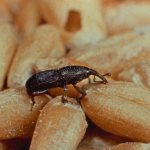 throughout the world. Weevils are basically beetles with ’snouts’. Well not all weevils have the snout but the rice and granary weevils do and it’s what makes them easily recognizable. The snout extends from the front of the head downward and at the tip are found the weevils mouth parts. Both the rice and granary weevils closely resemble each other. 1/8 to 3/16 of an inch and are dark to reddish brown. The main visible difference is that each weevil has pits on the prothorax. (the area just behind the head) Rice weevils are round while the granary’s are oval. rice weevils can fly while granary cannot. Even though these weevils are present throughout the world, the granary weevil is found more in the northern states and can withstand colder weather while the rice weevils need it warmer and therefore are more prevalent in the south. Another interesting fact is that these weevils ‘play dead’ when disturbed for several minutes as a defense against would be predators. The female chews a hole into a kernel of grain and deposits an egg. She then seals the hole and moves to the next kernel. Her life span is 4 to 5 months and she’ll lay approximately 300 to 400 eggs during that time. As a general rule only 50% of the eggs ever hatch. The larva live and eat the inside of the kernel till maturing which can be as little as 26 days under ideal conditions but usually takes longer. When pupation is done the adult weevil chews a hole in the kernel to exit through but does not seal it up. Both weevils are internal feeders primarily feeding on whole grain but have been found on macaroni, spaghetti and old pasta when it becomes old and caked. Inspection and control tips are the same as listed above- just be sure to be thorough.
throughout the world. Weevils are basically beetles with ’snouts’. Well not all weevils have the snout but the rice and granary weevils do and it’s what makes them easily recognizable. The snout extends from the front of the head downward and at the tip are found the weevils mouth parts. Both the rice and granary weevils closely resemble each other. 1/8 to 3/16 of an inch and are dark to reddish brown. The main visible difference is that each weevil has pits on the prothorax. (the area just behind the head) Rice weevils are round while the granary’s are oval. rice weevils can fly while granary cannot. Even though these weevils are present throughout the world, the granary weevil is found more in the northern states and can withstand colder weather while the rice weevils need it warmer and therefore are more prevalent in the south. Another interesting fact is that these weevils ‘play dead’ when disturbed for several minutes as a defense against would be predators. The female chews a hole into a kernel of grain and deposits an egg. She then seals the hole and moves to the next kernel. Her life span is 4 to 5 months and she’ll lay approximately 300 to 400 eggs during that time. As a general rule only 50% of the eggs ever hatch. The larva live and eat the inside of the kernel till maturing which can be as little as 26 days under ideal conditions but usually takes longer. When pupation is done the adult weevil chews a hole in the kernel to exit through but does not seal it up. Both weevils are internal feeders primarily feeding on whole grain but have been found on macaroni, spaghetti and old pasta when it becomes old and caked. Inspection and control tips are the same as listed above- just be sure to be thorough.
Here are some unexpected places where you may find these critters. Animal carcasses, cork boards, accumulations of rodent, bird and bat droppings, dried flower arrangements, bean or seed mosaics, pepper wreaths and dried peppers, bean bag toys and chairs, fish food, drugs, art brushes made of animal hair, stuffing in upholstered furniture, decorative Indian corn arrangements, leather goods, bird and rodent nests, silk linings of suitcases and trunks, packing material made from corn starch, rodent bait, stored flower bulbs, bird seed, stuffed dolls and animals, wall tapestries, tobacco, poupourri, old books, bone meal, feather, and insect collections.
Control methods for beetles and weevils is pretty much the same as for moths just make sure no stone is left unturned in searching for the infested product. That will be key to elimination of these pests in every case.
Lesser Grain Beetle, Larger Grain Borer, Bean and Cowpea Weevils, Groundnut Bruchid, Warehouse 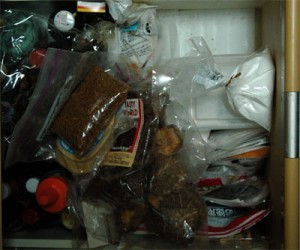 and Cabinet Beetles, Sap Beetles, Squarenecked Grain Beetle, Sawtoothed and Merchant Beetles, Flat and Rusty Grain Beetles, Red and Confused Flour Beetles, Spider Beetles, Cadelle, Yellow and Dark Mealworm Beetles and Lesser Meal are other pantry pest’s to look out for.
and Cabinet Beetles, Sap Beetles, Squarenecked Grain Beetle, Sawtoothed and Merchant Beetles, Flat and Rusty Grain Beetles, Red and Confused Flour Beetles, Spider Beetles, Cadelle, Yellow and Dark Mealworm Beetles and Lesser Meal are other pantry pest’s to look out for.
There is quite a variety but for the better part of 25 years I’ve only seen a few of the odd infestations listed above but countless calls have been due to the featured stored product pests written I have written on. So the next time you see a wandering beetle or a fluttering moth, do a little look see in the pantry. You may have unwanted dinner guests.

